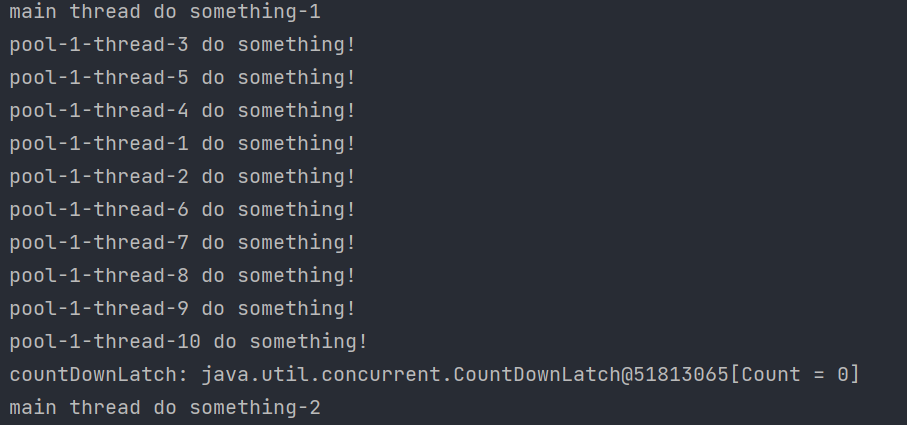CountDownLatch一般用作多线程倒计时计数器,强制它们等待其他一组(CountDownLatch的初始化决定)任务执行完成,CountDownLatch初始化后计数器值递减到0的时候,不能再复原的。
源码
1 2 3 4 5 6 7 8 9 10 11 12 13 14 15 16 17 18 19 20 21 22 23 24 25 26 27 28 29 30 31 32 33 34 35 36 37 38 39 40 41 42 43 44 45 46 47 48 49 50 51 52 53 54 55 56 57 58 59 60 61 62 package java.util.concurrent;import java.util.concurrent.locks.AbstractQueuedSynchronizer;public class CountDownLatch { private static final class Sync extends AbstractQueuedSynchronizer { private static final long serialVersionUID = 4982264981922014374L ; Sync(int count) { setState(count); } int getCount () { return getState(); } protected int tryAcquireShared (int acquires) { return (getState() == 0 ) ? 1 : -1 ; } protected boolean tryReleaseShared (int releases) { for (;;) { int c = getState(); if (c == 0 ) return false ; int nextc = c - 1 ; if (compareAndSetState(c, nextc)) return nextc == 0 ; } } } private final Sync sync; public CountDownLatch (int count) { if (count < 0 ) throw new IllegalArgumentException ("count < 0" ); this .sync = new Sync (count); } public void await () throws InterruptedException { sync.acquireSharedInterruptibly(1 ); } public boolean await (long timeout, TimeUnit unit) throws InterruptedException { return sync.tryAcquireSharedNanos(1 , unit.toNanos(timeout)); } public void countDown () { sync.releaseShared(1 ); } public long getCount () { return sync.getCount(); } public String toString () { return super .toString() + "[Count = " + sync.getCount() + "]" ; } }
使用示例:
1 2 3 4 5 6 7 8 9 10 11 12 13 14 15 16 17 18 19 20 21 22 23 24 25 26 27 28 29 30 31 32 33 34 35 36 37 38 39 40 41 public class CountDownLatchModule { private static int N = 10 ; private static int countDownLatchTimeout = 5 ; public static void main (String[] args) { CountDownLatch countDownLatch = new CountDownLatch (N); ExecutorService cachedThreadPool = Executors.newCachedThreadPool(); for (int i = 0 ; i < N; i++) { cachedThreadPool.execute(() ->{ try { System.out.println(Thread.currentThread().getName() + " do something!" ); } catch (Exception e) { System.out.println("Exception: do something exception" ); } finally { countDownLatch.countDown(); } }); } System.out.println("main thread do something-1" ); try { countDownLatch.await(countDownLatchTimeout, TimeUnit.MINUTES); } catch (InterruptedException e) { System.out.println("Exception: await interrupted exception" ); } finally { System.out.println("countDownLatch: " + countDownLatch.toString()); } System.out.println("main thread do something-2" ); }
结果输出:
public void await() throws InterruptedException:调用await()方法的线程会被挂起,等待直到count值为0再继续执行。public boolean await(long timeout, TimeUnit unit) throws InterruptedException:同await(),若等待timeout时长后,count值还是没有变为0,不再等待,继续执行。时间单位如下常用的毫秒、天、小时、微秒、分钟、纳秒、秒。public void countDown(): count值递减1。public long getCount():获取当前count值。public String toString():重写了toString()方法,多打印了count值。
CountDownLatch使用场景 一个程序中有N个任务在执行,我们可以创建值为N的CountDownLatch,当每个任务完成后,调用一下countDown()方法进行递减count值,再在主线程中使用await()方法等待任务执行完成,主线程继续执行。
**示例: **作为线程启动信号。
1 2 3 4 5 6 7 8 9 10 11 12 13 14 15 16 17 18 19 20 21 22 23 24 25 26 27 28 29 30 31 32 33 34 35 36 37 38 39 40 41 42 43 @Test void test2 () throws InterruptedException { CountDownLatch startSignal = new CountDownLatch (1 ); CountDownLatch doneSignal = new CountDownLatch (10 ); for (int i = 0 ; i < 10 ; i++) { new Thread (new Worker (startSignal, doneSignal)).start(); } System.out.println("do something else 1" ); startSignal.countDown(); System.out.println("do something else 2" ); doneSignal.await(); System.out.println("wait for all to finsh" ); } static class Worker implements Runnable { private final CountDownLatch startSignal; private final CountDownLatch doneSignal; Worker(CountDownLatch startSignal, CountDownLatch doneSignal) { this .startSignal = startSignal; this .doneSignal = doneSignal; } @Override public void run () { try { this .startSignal.await(); doWork(); this .doneSignal.countDown(); } catch (InterruptedException ex) { ex.printStackTrace(); } } void doWork () { System.out.println("do work!" ); } }
结果输出
1 2 3 4 5 6 7 8 9 10 11 12 13 do something else 1 do work!do work!do work!do work!do work!do work!do something else 2 do work!do work!do work!do work!wait for all to finsh
主线程先打印do something else 1和do something else 2。因为startSignal.countDown();完后,count才为0,子线程才能打印。
因为startSignal.await();是在子线程内,所有子线程都等待startSignal.countDown()执行后才能打印do work!。
doneSignal.await();等待所有子线程执行后,每次都doneSignal.countDown(),最后count为0,主线程才执行打印wait for all to finsh。
**示例: **作为线程等待完成信号。
1 2 3 4 5 6 7 8 9 10 11 12 13 14 15 16 17 18 19 20 21 22 23 24 25 26 27 28 29 30 31 32 33 34 35 36 37 38 39 40 41 42 @Test void test3 () throws InterruptedException { CountDownLatch doneSignal = new CountDownLatch (5 ); ExecutorService cachedThreadPool = Executors.newCachedThreadPool(); for (int i = 0 ; i < 10 ; i++) { cachedThreadPool.execute(new Work (doneSignal, i)); } System.out.println("do something else 1" ); doneSignal.await(); System.out.println("===========================count: " + doneSignal.getCount()); System.out.println("do something else 2" ); cachedThreadPool.shutdown(); } static class Work implements Runnable { private final CountDownLatch doneSignal; private final int i; Work(CountDownLatch doneSignal, int i) { this .doneSignal = doneSignal; this .i = i; } @Override public void run () { try { doWork(); this .doneSignal.countDown(); System.out.println("i = " + this .i + ", " + this .doneSignal.toString()); } catch (Exception ex) { ex.printStackTrace(); } } void doWork () { System.out.println("do work!" ); } }
结果输出
1 2 3 4 5 6 7 8 9 10 11 12 13 14 15 16 17 18 19 20 21 22 23 do work!do work!do work!do work!do work!do work!i = 3 , java.util.concurrent.CountDownLatch@707128b6[Count = 1 ] i = 5 , java.util.concurrent.CountDownLatch@707128b6[Count = 0 ] i = 4 , java.util.concurrent.CountDownLatch@707128b6[Count = 0 ] i = 2 , java.util.concurrent.CountDownLatch@707128b6[Count = 2 ] do work!i = 6 , java.util.concurrent.CountDownLatch@707128b6[Count = 0 ] i = 0 , java.util.concurrent.CountDownLatch@707128b6[Count = 3 ] i = 1 , java.util.concurrent.CountDownLatch@707128b6[Count = 3 ] do work!i = 7 , java.util.concurrent.CountDownLatch@707128b6[Count = 0 ] do work!i = 8 , java.util.concurrent.CountDownLatch@707128b6[Count = 0 ] do something else 1 do work!i = 9 , java.util.concurrent.CountDownLatch@707128b6[Count = 0 ] ===========================count: 0 do something else 2
主线程是等待其他线程运行了5次结束后就打印了do something else 2信息,因为CountDownLatch数值为5。
